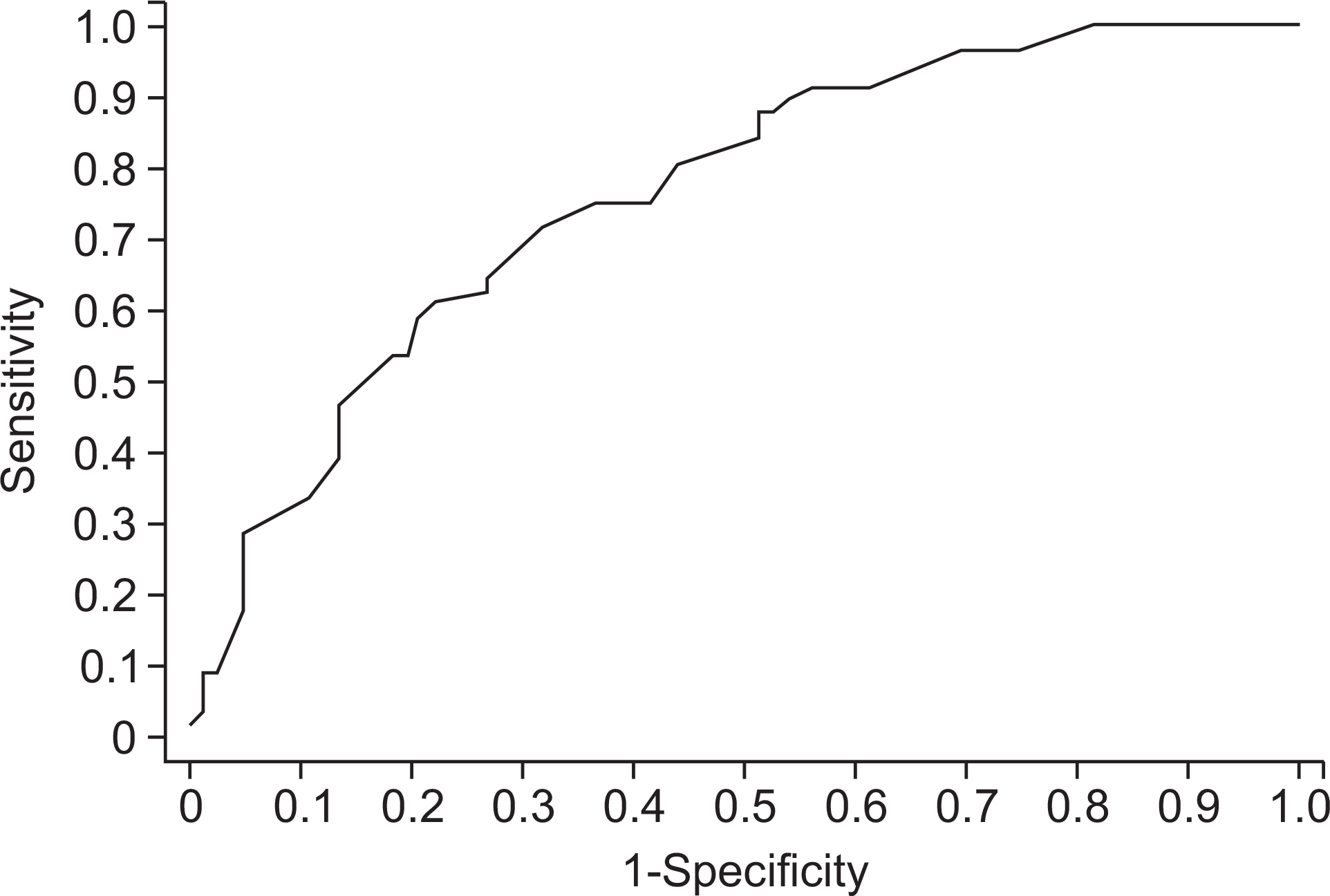Abstract
Objectives
The present study aimed to evaluate the validity of a set of self-reported questionnaires for periodontitis for estimating the prevalence of chronic adult periodontitis in the Korean population.
Methods
The questionnaire is comprised of a total of 14 questions with four summarized concepts including self-diagnosis of oral status, subjective signs related to oral health, smoking and drinking status, and use of auxiliary oral hygiene devices including scaling. The predictiveness of the measures from these self-reported questions was assessed by logistic regression modeling using receiver operating characteristic (ROC) statistics, sensitivity, and specificity.
Results
The sensitivity, specificity, and AUC including all questions were 0.571, 0.768, and 0.781, respectively; the sum of sensitivity and specificity was 1.34. To gain robustness, a simplified predictive model was built with six questions. Its results were 0.536, 0.817, and 0.762 for sensitivity, specificity, and AUC, respectively. The sum of sensitivity and specificity was found to be 1.35.
Go to : 
References
1. Albandar JM, Rams TE. Global epidemiology of periodontal dis-eases: an overview. Periodontol 2000. 2002; 29:7–10.

3. Seymour GJ, Ford PJ, Cullinan MP, Leishman S, Yamazaki K. Relationship between periodontal infections and systemic disease. Clin Microbiol Infect. 2007; 13:3–10.

4. Health Insurance Review and Assessment Service, Nation Helath Insurance Corporation. 2010 National Health Insurance Statistical Yearbook. Seoul: Health Insurance Review & Assessment Service, Nation Health Insurance Corporation;2011. p. 556.
5. Ministry of Health and Welfare. 2011 Korea Health Statistics: Korea National Health and Nutrition Examination Survey (KNHANES V-2). Seoul: Ministry of Health & Welfare;2012. p. 15.
6. Eke PI, Dye BA, Wei L, Slade GD, Thornton-Evans GO, Beck JD, et al. Self-reported measures for surveillance of periodontitis. J Dent Res. 2013; 92:1041–1047.

7. WHO. Oral health surveys: basic methods. 4th ed.Geneva: World Health Organization;2000. p. 27–37.
8. Centers for Disease Control and Prevention. [Internet]. [cited 2014 Aug 20]. Available at:. http://www.cdc.gov/brfss/.
9. Vartiainen E, Seppälä T, Lillsunde P, Puska P. Validation of self reported smoking by serum cotinine measurement in a community-based study. J Epidemiol Community Health. 2002; 56:167–170.

10. Okura Y, Urban LH, Mahoney DW, Jacobsen SJ, Rodeheffer RJ. Agreement between self-report questionnaires and medical record data was substantial for diabetes, hypertension, myocardial infarction and stroke but not for heart failure. J Clin Epidemiol. 2004; 57:1096–1103.

11. Eke PI, Genco RJ. CDC Periodontal Disease Surveillance Project: background, objectives, and progress report. J Periodontol. 2007; 78:1366–1371.

12. Slade GD. Interim analysis of validity of periodontitis screening questions in the Australian population. J Periodontol. 2007; 78:1463–1470.

13. Yamamoto T, Koyama R, Tamaki N, Maruyama T, Tomofuji T, Ekuni D, et al. Validity of a questionnaire for periodontitis screening of Japanese employees. J Occup Health. 2009; 51:137–143.

14. Jin HJ, Bae GH, Kim JB, Park DY, Jeong SH, Kim BI, et al. Validity and reliability of a questionnaire for evaluating periodontal disease. J of Korean Acad of Oral Health. 2014; 38:170–175.

15. WHO. Basic methods. Seoul: Komoonsa;2000. p. 27–37.
16. Ministry of Health and Welfare. 2000 Korean National Oral Health Survey. Summary. Seoul: Ministry of Health and Welfare;2001. p. 34.
Go to : 
Table 1.
Distribution of the study population by self-reported (response reclassification)
Table 2.
Logistic regression model (model I) to predict periodontitis
Table 3.
Logistic regression model (model II) to predict periodontitis




 PDF
PDF ePub
ePub Citation
Citation Print
Print




 XML Download
XML Download